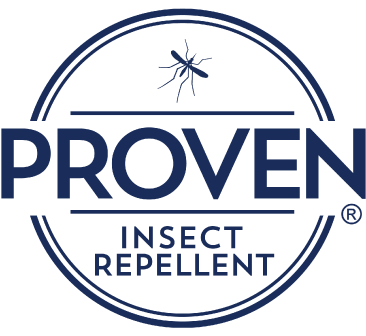Saltidin (Picaridin): Scientific information
What is Saltidin (also known as Picaridin and Icaridin)?
Saltidin is an active ingredient with a broad-spectrum of effectiveness. It prevents bites from numerous species of arthropods. Saltidin repellents are intended to be used by the general public, including adults and children.123
Chemical Overview
| Chemical type | Pesticide – insect and acarid repellent |
| Chemical family | Piperidines |
| Common names | Picaridin, icaridin, KBR 3023, propidine |
| Trade names | Bayrepel®, Saltidin® |
| INCI name | Hydroxyethyl isobutyl piperidine carboxylate |
| IUPAC name | 1-piperidinecarboxylic acid 2-(2-hydroxyethyl)-1-methylpropylester |
| CA name | sec-Butyl 2-(2-hydroxyethyl) piperidine-1-carboxylate |
| CAS No. | 119515-38-7 |
| Molecular formula | C12H23NO3 |
| Molecular mass | 229.3 g/mol |
| Physical state | Liquid |
| Odor | Nearly odorless |
| Color | Colorless |
| Molecular Structure | 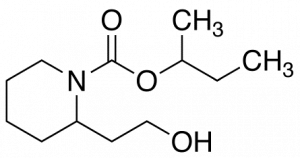 |
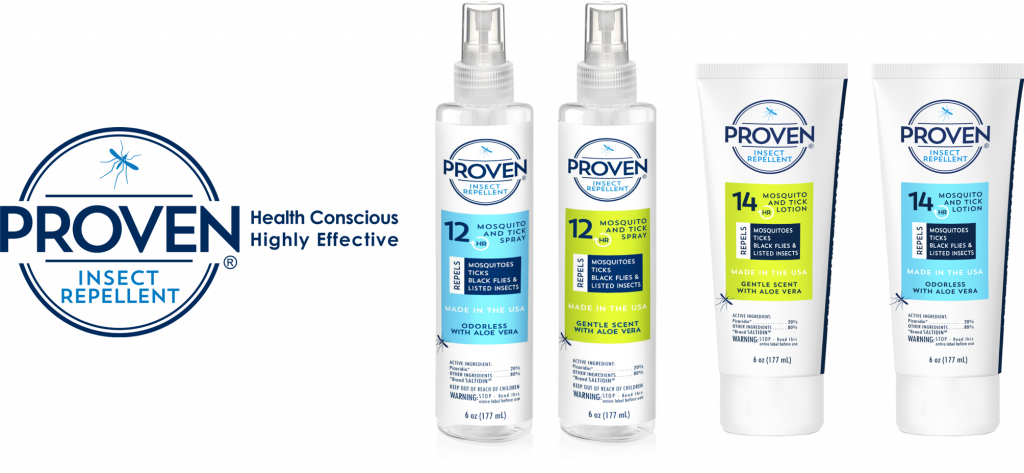
HISTORY
A Need for New Repellents
DEET has been the standard insect repellent since becoming commercially available in 1957.4 However, there are increasing concerns related to health. DEET also has an unpleasant smell, a sticky feeling on skin, and it dissolves plastics. These traits have led to a demand for identifying new repellent molecules.5678
The Development of Saltidin
Picaridin was developed by Bayer AG in the 1980s.3 The repellent was first released under the trade name Bayrepel and sold under the brand Autan.91 In 2008, LANXESS and Saltigo split off from Bayer, and the trade name was changed Saltidin.10
Saltidin is part of a new generation of customized repellents. Molecular modeling techniques were used to map and construct three-dimensional molecules. Saltidin was designed under the hypothesis that the repellent effect was caused by interaction with an insect’s olfactory (smell) receptors.1 Known repellent compounds were altered at sites where interaction with receptors was anticipated. Through this process, more than 800 substances were synthesized and screened for efficacy, safety and compatibility with skin. Of these compounds, Saltidin (KBR 3023) was the best candidate.111 It became the first synthetic repellent to go through modern efficacy and safety tests as part of the creation process.212
Saltidin’s molecular structure is based on piperidine, a colorless organic compound with a peppery odor.131415 It’s similar to the alkaloid in peppers (piperine) that creates the hot flavor.1615 Saltidin is colorless, odorless, non-greasy, and compatible with skin, gear and plastic.3171
Consumer Availability
Picaridin has been in public use since 1998 in Australia and since 2001 in Europe.18195132021 It was registered with the Environmental Protection Agency (EPA) in 2001.17 Picaridin has enjoyed significant market penetration since its inception. It’s now registered as an insect repelling active ingredient in over 50 countries.3222
Registration & Recommendations
In 2000, the World Health Organization (WHO) recommended picaridin as the repellent of choice for malaria prevention.1 In 2001, the EPA registered picaridin for commercial use, stating that it wasn’t significantly toxic.23 Insect repellents don’t require FDA approval.20 In 2005, the Centers for Disease Control (CDC) added picaridin to their list of recommended repellents for prevention of arthropod-borne illness.32018
Saltidin vs DEET
DEET has been the most widely used repellent for six decades.19 DEET is patent-free and cost-efficient. Though DEET is popularly used, there are drawbacks related to its cosmetic properties. It also isn’t the best repellent against certain biting arthropods like ticks.25 These downsides allow for market penetration of alternative repellents. Saltidin, for example, is better tolerated on skin, has a lower toxicity and is better in efficacy compared to similar percentages of DEET.1971324
Cosmetic Properties
Saltidin has near-ideal cosmetic properties. It’s compatible with skin, mucous membranes and plastic materials. The compound is stable toward light, water, sweat and oxidation.1 It’s also biodegradable.26 Saltidin is odorless, doesn’t feel sticky or greasy, and skin irritation is uncommon.192126 Those surveyed repeatedly report they prefer Saltidin to DEET because of these properties.2721
User Acceptability
A questionnaire regarding insect repellent use was given to the Australian Defence Force. Of the soldiers surveyed, 80% won’t use the issued repellent (35% DEET gel) during their deployment because it feels unpleasant and dissolves plastics. In 2001, 150 soldiers were asked to compare the 35% DEET gel with a 19.2% Saltidin pump spray. The soldiers used each repellent for a week, applying it twice a day. Saltidin was preferred by 94% of the soldiers. DEET caused significantly more reports of skin irritation (see Fig 1).21
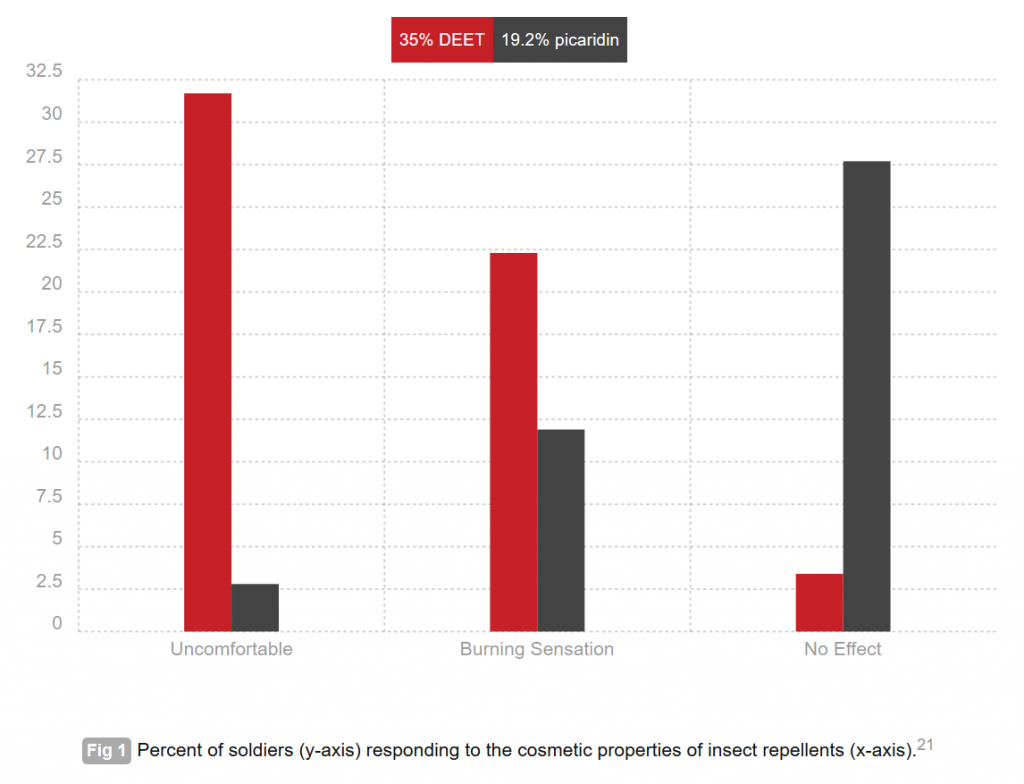
Other user acceptability questionnaires provide similar results. DEET is disliked due to its odor, skin reactions and uncomfortable oily, sticky feeling. Users also don’t like how DEET can damage synthetic clothes, leather, and plastics on eyeglass frames and watches.202721
Efficacy
Targeted Arthropods
Saltidin is a broad-spectrum repellent. It’s effective at repelling a variety of biting arthropods, including mosquitoes, ticks, flies, gnats, chiggers, midges, fleas and sand flies.11928 Saltidin has also been demonstrated to repel ants and cockroaches.29
Effective Duration
Saltidin starts repelling insects immediately after being applied to skin. It develops full performance within a few minutes.1 How long it lasts depends upon the targeted pest. Proven® Insect Repellent Spray has a 20% formulation of Saltidin and protects users from bites for 12 hours. Proven® Lotion also has a 20% formulation of Saltidin and protects for 14 hours.
Saltidin lasts longer on skin than DEET or IR3535. It persists on skin even in high temperatures and moist air.24 This is an important factor considering that moderate levels of physical activity (jogging, cycling) can reduce the protection time of DEET by 40%.33
Against Mosquitoes
Numerous studies have compared the effectiveness of Saltidin and DEET against mosquitoes. Results vary by species, but generally the efficacy of Saltidin is superior to DEET in equal concentrations.7830222427323435 Saltidin has also been demonstrated to be superior to DEET and IR3535 at repelling mosquitoes.2453435
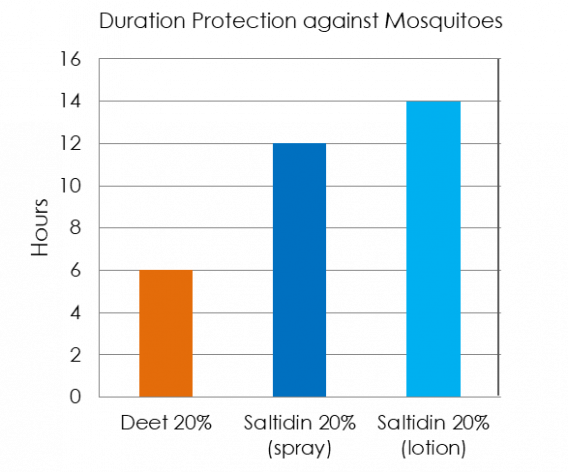
Against Ticks
Saltidin is effective at deterring ticks, demonstrated in studies on lone star ticks (Amblyomma americanum).3613738 Sunscreen repellents slightly decrease efficacy.1
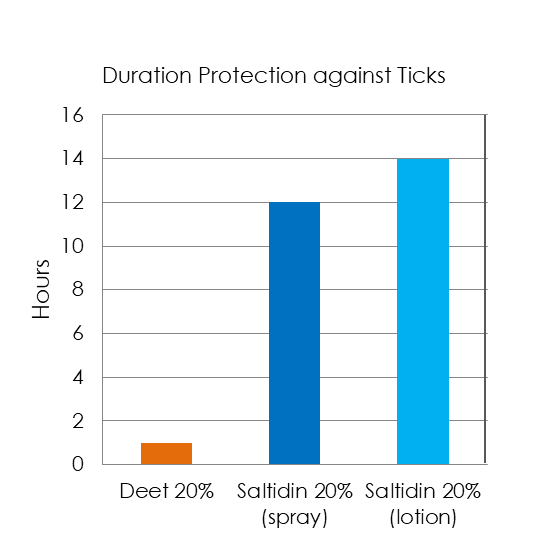
The protection of DEET against ticks is very low compared with the same percentages of Saltidin.
Against Biting Flies
Saltidin is effective at repelling biting flies, as demonstrated in studies against sand flies (P. duboscqi and P. papatasi) and black flies (Simulium venustum).404142 Against the black fly, Saltidin provided over 95% protection from bites for 8 hours, while DEET only offered 90% protection.42 Against sand flies, 20% formulations of Saltidin performed better to a 50% DEET.41
Against Fleas
Saltidin is an effective repellent of cat fleas (Ctenocephalides felis). 20% Saltidin offers complete protection from flea bites for 9 hours.29
Against No-see-ums
20% Saltidin protects effectively protects against No-see-ums for up to 8 hours after being applied to skin.43
Mode of Action
Insect repellents work through interactions with olfactory receptors (smell) and gustatory receptors (taste).45 Saltidin appears to work by preventing mosquitoes, ticks and other insects from sensing their prey.
Olfactory Receptors
Different repellent compounds have different chemical structures and affect different olfactory receptors (OR). They don’t have a common mode of action.4849 Insect repellents are agonists, activating ORs even in the absence of a host. They’re also antagonists which inhibit the ability of insects to detect nearby hosts. Lastly, repellents are synergistic, hyper-activating the receptors and causing confusion in host detection.5047
Saltidin doesn’t act upon the same receptors that are involved in host attraction. The repellent triggers its own chemosensory response in the antennae. The mode of action isn’t a masking or suppressing effect. Antagonistic effects are caused by receptor cells unrelated to host odors or pheromones that are counteracting the attraction response.11 When Saltidin is presented with an attractant, a new, unique input is activated in the insect’s brain. This scrambled pattern differs greatly from the attractant. The insect can’t understand it. As a result, they can no longer detect the host.11148
Insecticidal Effect
Saltidin doesn’t have any insecticidal effect. However, DEET does. Saltidin also doesn’t affect flight take-off like some other repellent compounds. This provides further evidence that repellents do not behave as a single class of compounds with a common mode of action.52
Oviposition Deterrent
In relatively low doses Saltidin repellents can deter insects from laying eggs. Mosquitoes won’t deposit eggs in areas where the compounds are present. Saltidin repellents are more effective and last longer in water than DEET.53
Antimicrobial Properties
Multiple insect repellents, including Saltidin, have antifungal and antibacterial properties. Saltidin has a stronger antibacterial effect than DEET.6
TOXICITY
Picaridin has a good toxicology profile. The WHO has stated it’s a safe and effective insect repellent for human use.27 The EPA concluded that Picaridin is not significantly toxic and can be safely used by adults and children.1 In 2000, Picaridin was recommended as the insect repellent of choice by the World Health Organization due to its safety and cosmetic features.1
Saltidin
Toxicity Data
I = Highly Toxic II = Moderately Toxic III = Slightly Toxic IV = Practically Non-Toxic
| Acute Dermal Exposure | III | |
| Acute Oral Exposure | III | |
| Acute Inhalation Exposure | IV | |
| Primary Skin Irritation | IV | |
| Primary Eye Irritation | III | |
| Dermal Sensitizer | no | |
| Carcinogen | no | |
| Fish | II | |
| Aquatic Invertebrates | IV | |
| Birds | IV |
Reports of Adverse Reactions
Skin reactions to Saltidin are rare.2013 There’s only been one report of an adverse effect. In 2005, a man had an allergic reaction to the repellent. However, he was also sensitive to the emulsifier used in the aerosol spray.13
Acute Toxicity
Saltidin has a low acute toxicity to mammals through all routes of exposure. It’s not irritating to skin and only slightly irritating to eyes. It’s practically non-toxic when inhaled and only slightly toxic when swallowed. Saltidin is not a skin sensitizer. No phototoxicity has been observed.27117
Pregnancy and breastfeeding
Saltidin insect repellents are safe for women who are pregnant or breastfeeding. Zika is spread mostly by the bite of an infected Aedes species mosquito (Ae. aegypti and Ae. albopictus). These mosquitoes bite during the day and night. Zika can be passed from a pregnant woman to her fetus. Infection during pregnancy can cause certain birth defects. No vaccine exists to prevent Zika. The mosquitoes that can spread Zika are found throughout the United States. Saltidin repellents like Proven Insect repellent offer the most effective and safe protection against Zika.
Cancer
SFor (ex) cancer patients it is recommended to use a non-toxic insect repellent like Saltidin base repellents. Saltidin is not likely to contribute to the development of cancer. Researchers did not see increases in cancer among laboratory animals after putting Picaridin on the animals’ skin for two years. The U.S. EPA decided that Picaridin is not likely to cause cancer based on long-term skin exposure studies in rats and mice.
Mucous Membranes
Saltidin has good compatibility with mucous membranes (e.g. nostrils, lips, eyelids and ears).1 DEET, on the other hand, irritates mucous membranes, making facial application inadvisable.13
Skin Absorption & Excretion
Saltidin is poorly absorbed through human skin, and that which gets absorbed is rapidly excreted. About 10% of the applied dose is absorbed through human skin over a 24 hour period.127 In an 8 hour period, less than 4% is absorbed. Over 94% of the absorbed dose gets excreted as metabolites through urine within the first 24 hours. The excretion half-life in humans is 8.2 hours at a low dose. Saltidin doesn’t accumulate in skin.127
Carcinogenicity
Studies haven’t found any carcinogenic or genotoxic effects of Saltidin when applied to skin..14 In 1999, the EPA Health Effects Division’s Hazard Identification Assessment Review Committee (HIARC) determined that Saltidin wasn’t likely to be a carcinogen by the dermal route, and found no evidence of endocrine disruption.117
Reproductive Toxicity
Studies on reproductive toxicity were done with rats and rabbits. There weren’t any statistically significant effects for any reproductive parameters when Saltidin was applied to skin. No developmental toxicity was observed at any dose level.5455
Neurotoxicity
There wasn’t any evidence of acute or chronic neurotoxicity when Saltidin was administered to the skin of rats. It also doesn’t bioaccumlate.2818
Pets & Other animals
Limited information exists on Picaridin’s adverse effects to domestic pets. There was one laboratory study with beagle dogs, and no adverse side effects were seen.46
Dogs aren’t known to get Zika, but they can get West Nile and they often get Heartworms from mosquitoes. People are using Saltidin based products on their pets and it seems to work, but there is no scientific proof. The EPA has recently approved 20% Picardin insect repellent as safe for horses.
Environmental Toxicity
The EPA has stated that Saltidin shouldn’t pose a risk to the environment through the proposed use.17 The WHO found Saltidin’s acute toxicity is low for water fleas (aquatic invertebrate) and rainbow trout.27 The EPA determined it’s moderately toxic to rainbow trout, practically non-toxic to water fleas, and somewhat hinders the growth of green algae. It’s non-toxic to birds.17
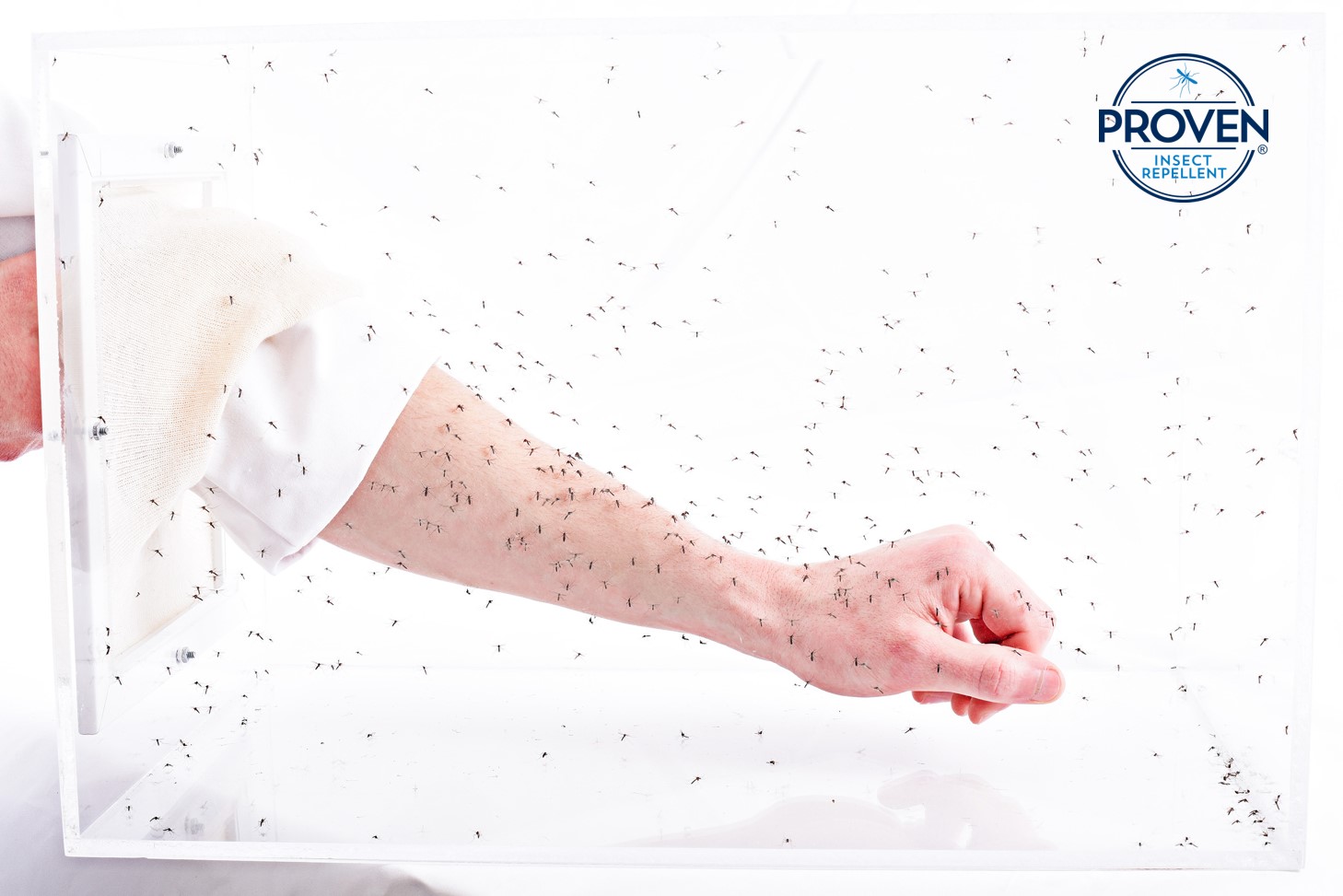
REFERENCES
1.
Krieger, R. Hayes’ Handbook of Pesticide Toxicology. (Academic Press, 2010).
2.
Strickman, D., Frances, S. P. & Debboun, M. Prevention of Bug Bites, Stings, and Disease. (Oxford University Press, 2009).
3.
Debboun, M., Frances, S. P. & Strickman, D. A. Insect Repellents: Principles, Methods, and Uses. (CRC Press, 2006).
4.
EPA. DEET: Reregistration Eligibility Decision (RED). (1998).
5.
Naucke, T. J. et al. Field evaluation of the efficacy of proprietary repellent formulations with IR3535® and Saltidin against Aedes aegypti. Parasitol Res 101, 169–177 (2007).
6.
Kalaycı, S., Demirci, S. & Sahin, F. Determination of antimicrobial properties of Saltidin and DEET against a broad range of microorganisms. World J. Microbiol. Biotechnol. 30, 407–411 (2014).
7.
Badolo, A., Ilboudo-Sanogo, E., Ouédraogo, A. P. & Costantini, C. Evaluation of the sensitivity of Aedes aegypti and Anopheles gambiae complex mosquitoes to two insect repellents: DEET and KBR 3023. Trop. Med. Int. Health 9, 330–334 (2004).
8.
Yap, H. H., Jahangir, K. & Zairi, J. Field efficacy of four insect repellent products against vector mosquitoes in a tropical environment. J. Am. Mosq. Control Assoc. 16, 241–244 (2000).
10.
Icaridin. Wikipedia, the free encyclopedia (2014).
11.
Boeckh, J. et al. Acylated 1,3-Aminopropanols as Repellents against Bloodsucking Arthropods. Pestic. Sci. 48, 359–373 (1996).
12.
Debboun, M., Frances, S. P. & Strickman, D. A. Insect Repellents Handbook. (CDC Press Taylor & Francis Group, 2014).
13.
Corazza, M., Borghi, A., Zampino, M. R. & Virgili, A. Allergic contact dermatitis due to an insect repellent: double sensitization to Saltidin and methyl glucose dioleate. Acta Derm. Venereol. 85, 264–265 (2005).
14.
Wahle, B. S., Sangha, G. K., Elcock, L. E., Sheets, L. P. & Christenson, W. R. Carcinogenicity testing in the CD-1 mouse of a prospective insect repellent (KBR 3023) using the dermal route of exposure. Toxicology 142, 29–39 (1999).
15.
Bissinger, B. W. & Roe, R. M. Tick repellents: Past, present, and future. Pesticide Biochemistry and Physiology 96, 63–79 (2010).
16.
Epstein, H. Repelling insects with safe and effective alternatives to DEET. Skinmed 10, 36–39 (2012).
17.
New Pesticide Fact Sheet: Saltidin. (2005).
18.
Wolverton, S. E. & Wolverton, S. E. Comprehensive Dermatologic Drug Therapy. (Elsevier Health Sciences, 2012).
19.
Katz, T. M., Miller, J. H. & Hebert, A. A. Insect repellents: historical perspectives and new developments. J. Am. Acad. Dermatol. 58, 865–871 (2008).
20.
Abramowicz, M. Saltidin – A New Insect Repellent. The Medical Letter 47, 46–47 (2005).
21.
Cooper, R. D. & Francis, S. P. Personal protection measures against mosquitoes. A brief history and current use of repellents by the Australian Defence Force. ADF Health 3, 58–63 (2002).
22.
Frances, S. P., Waterson, D. G. E., Beebe, N. W. & Cooper, R. D. Field evaluation of repellent formulations containing deet and Saltidin against mosquitoes in Northern Territory, Australia. J. Med. Entomol. 41, 414–417 (2004).
23.
Kozarsky, P., Freedman, D. O., Nothdurft, H. D. & Connor, B. A. Travel Medicine. (Elsevier Health Sciences, 2013).
24.
Costantini, C., Badolo, A. & Ilboudo-Sanogo, E. Field evaluation of the efficacy and persistence of insect repellents DEET, IR3535, and KBR 3023 against Anopheles gambiae complex and other Afrotropical vector mosquitoes. Transactions of the Royal Society of Tropical Medicine and Hygiene 98, 644–652 (2004).
25.
Debboun, M. et al. Laboratory evaluation of AI3-37220, AI3-35765, CIC-4, and deet repellents against three species of mosquitoes. J. Am. Mosq. Control Assoc. 15, 342–347 (1999).
26.
Van Roey, K. et al. Field evaluation of Saltidin repellents reveals differences in repellent sensitivity between Southeast Asian vectors of malaria and arboviruses. PLoS Negl Trop Dis 8, e3326 (2014).
27.
Report of the Fourth WHOPES Working Group Meeting — Review of: IR3535; KBR3023; (S)-Methoprene 20% EC, Pyriproxyfen 0.5% Gr; and Lambda-Cyhalothrin 2.5% CS. (2000).
28.
Antwi, F. B., Shama, L. M. & Peterson, R. K. D. Risk assessments for the insect repellents DEET and Saltidin. Regul. Toxicol. Pharmacol. 51, 31–36 (2008).
29.
Saltidin Newsletter: ALL Family Insect Repellent Spray 20%. (2001).
30.
Frances, S. P., Van Dung, N., Beebe, N. W. & Debboun, M. Field evaluation of repellent formulations against daytime and nighttime biting mosquitoes in a tropical rainforest in northern Australia. J. Med. Entomol. 39, 541–544 (2002).
31.
Scott, J. M., Hossain, T., Davidson, C., Smith, M. L. & Xue, R.-D. Laboratory evaluation of citronella, Saltidin, and deet repellents against Psorophora ciliata and Psorophora howardii. J. Am. Mosq. Control Assoc. 30, 136–137 (2014).
32.
Barnard, D. R. & Xue, R.-D. Laboratory evaluation of mosquito repellents against Aedes albopictus, Culex nigripalpus, and Ochierotatus triseriatus (Diptera: Culicidae). J. Med. Entomol. 41, 726–730 (2004).
33.
Schofield, S., Tepper, M. & Gadawski, R. Laboratory and field evaluation of the impact of exercise on the performance of regular and polymer-based deet repellents. J. Med. Entomol. 44, 1026–1031 (2007).
34.
Barnard, D. R., Bernier, U. R., Posey, K. H. & Xue, R.-D. Repellency of IR3535, KBR3023, para-menthane-3,8-diol, and Deet to Black Salt Marsh Mosquitoes (Diptera: Culicidae) in the Everglades National Park. Journal of Medical Entomology 39, 895–899 (2002).
35.
Frances, S. P., Marlow, R. M., Jansen, C. C., Huggins, R. L. & Cooper, R. D. Laboratory and field evaluation of commercial repellent formulations against mosquitoes (Diptera: Culicidae) in Queensland, Australia. Australian Journal of Entomology 44, 431–436 (2005).
36.
Carroll, J. F., Benante, J. P., Kramer, M., Lohmeyer, K. H. & Lawrence, K. Formulations of deet, Saltidin, and IR3535 applied to skin repel nymphs of the lone star tick (Acari: Ixodidae) for 12 hours. J. Med. Entomol. 47, 699–704 (2010).
37.
Solberg, V. B. et al. Field evaluation of deet and a piperidine repellent (AI3-37220) against Amblyomma americanum (Acari: Ixodidae). J. Med. Entomol. 32, 870–875 (1995).
38.
Carroll, J. F. et al. Twelve-hour duration testing of cream formulations of three repellents against Amblyomma americanum. Med. Vet. Entomol. 22, 144–151 (2008).
39.
Pretorius, A.-M., Jensenius, M., Clarke, F. & Ringertz, S. H. Repellent efficacy of DEET and KBR 3023 against Amblyomma hebraeum (Acari: Ixodidae). J. Med. Entomol. 40, 245–248 (2003).
40.
Klun, J. A., Khrimian, A. & Debboun, M. Repellent and deterrent effects of SS220, Saltidin, and Deet suppress human blood feeding by Aedes aegypti, Anopheles stephensi, and Phlebotomus papatasi. J. Med. Entomol. 43, 34–39 (2006).
41.
Perrotey, S., Madulo-Leblond, G. & Pesson, B. Laboratory testing of the insect repellent KBR 3023 against Phlebotomus duboscqi (Diptera: Psychodidae). Parasitol. Res. 88, 712–713 (2002).
42.
Debboun, M. et al. Field evaluation of deet and a piperidine repellent against Aedes communis (Diptera: Culicidae) and Simulium venustum (Diptera: Simuliidae) in the Adirondack Mountains of New York. J. Med. Entomol. 37, 919–923 (2000).
43.
Carpenter, S. et al. Repellent efficiency of BayRepel against Culicoides impunctatus (Diptera: Ceratopogonidae). Parasitol Res 95, 427–429 (2005).
44.
Terriquez, J. A., Klotz, S. A., Meister, E. A., Klotz, J. H. & Schmidt, J. O. Repellency of DEET, Saltidin, and three essential oils to Triatoma rubida (Hemiptera: Reduviidae: Triatominae). J. Med. Entomol. 50, 664–667 (2013).
45.
Dickens, J. C. & Bohbot, J. D. Mini review: Mode of action of mosquito repellents. Pesticide Biochemistry and Physiology 106, 149–155 (2013).
46.
Koch, S. N., Torres, S. M. F. & Plumb, D. C. Canine and Feline Dermatology Drug Handbook. (John Wiley & Sons, 2012).
47.
Sanford, J. L., Shields, V. D. C. & Dickens, J. C. Gustatory receptor neuron responds to DEET and other insect repellents in the yellow-fever mosquito, Aedes aegypti. Naturwissenschaften 100, 269–273 (2013).
48.
Bohbot, J. D. & Dickens, J. C. Insect Repellents: Modulators of Mosquito Odorant Receptor Activity. PLoS ONE 5, e12138 (2010).
49.
Bohbot, J. D. et al. Multiple activities of insect repellents on odorant receptors in mosquitoes. Med. Vet. Entomol. 25, 436–444 (2011).
50.
Bohbot, J. D. & Dickens, J. C. Odorant receptor modulation: Ternary paradigm for mode of action of insect repellents. Elsevier 62, (2012).
51.
Sanford, J. L., Barski, S. A., Seen, C. M., Dickens, J. C. & Shields, V. D. C. Neurophysiological and Behavioral Responses of Gypsy Moth Larvae to Insect Repellents: DEET, IR3535, and Saltidin. PLoS ONE 9, e99924 (2014).
52.
Licciardi, S., Herve, J. P., Darriet, F., Hougard, J.-M. & Corbel, V. Lethal and behavioural effects of three synthetic repellents (DEET, IR3535 and KBR 3023) on Aedes aegypti mosquitoes in laboratory assays. Medical and Veterinary Entomology 20, 288–293 (2006).
53.
Xue, R. D., Barnard, D. R. & Ali, A. Laboratory and field evaluation of insect repellents as oviposition deterrents against the mosquito Aedes albopictus. Med. Vet. Entomol. 15, 126–131 (2001).
54.
Astroff, A. B., Young, A. D., Holzum, B., Sangha, G. K. & Thyssen, J. H. Conduct and interpretation of a dermal developmental toxicity study with KBR 3023 (a prospective insect repellent) in the Sprague-Dawley rat and Himalayan rabbit. Teratology 61, 222–230 (2000).
55.
Astroff, A. B. et al. The conduct of a two-generation reproductive toxicity study via dermal exposure in the Sprague-Dawley rat–a case study with KBR 3023 (a prospective insect repellent). Reprod. Toxicol. 13, 223–232 (1999).
